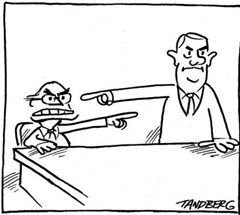 We are so often caught up in the reactive, and it is an inevitable part of life and business. There is too much data to be able to anticipate all of it coming at us. So how do we make a transition from reactive to preemptive?
We are so often caught up in the reactive, and it is an inevitable part of life and business. There is too much data to be able to anticipate all of it coming at us. So how do we make a transition from reactive to preemptive?
Know the Destination
You can’t go somewhere unless you know where you are going. Simple, I know. But do you jump in your car to go somewhere without having a destination in mind? Probably not. So what does your professional destination look like?
Taking time to plan an endgame is necessary for a huge transition. You need to be able to define success not only for you as a leader, but for the team as well so that there is a sense of momentum and, ultimately, accomplishment.
Set up Your Waypoints
Every flight plan has waypoints, intermediate destinations that help to set the overall course. Your journey from Reactive to Proactive should have waypoints as well. In Project Management they are called Milestones.
The purpose of the waypoint is to provide you with a series of connected destinations that help to ensure a safe path is set and that you are moving in the right direction. You can choose your waypoints to be in units of time, percent completion, accomplishment of specific events, or even arrival of the destination for only a part of the entire vision (completing the journey for one product line before expanding to another).
Understand Your Compromises
It’s difficult to get everything you want. By knowing where you need to compromise you allow yourself a safety that will prevent you and your team from being discouraged. Know where you can balk and where you mustn’t in order to help ensure success. Some areas cannot be compromised, define them. Others can be sacrificial should circumstances require it, be ready to sacrifice.
Communicate Your Destination
Give others the vision you have. Allow your team and your supporters to envision the destination with you. Take every moment you have to describe your destination in detail. Outline how it looks and give them the ability to see it with you. This will make others hungry to help you succeed.
If I told you we were going on a road trip your first question would be, “Where to?” If I simply said, “West,” that wouldn’t be very motivating. If I said, “The beach,” that might be more motivating. But if I took the time to describe the beach, how it looked at sunset, the warm breeze that blew on my face, the sound of the waves crashing on the nearby cliffs, and the long boardwalk the stretched over the water, you might be more excited about going there.
Invest in the Change
Change is a movement of inertia. The organization has momentum in its current direction. If you want to change that direction, you have to be willing to invest in the force required to overcome that inertia. This investment may come in the form of additional people, a new technology, external support, rebranding and marketing, or a number of other things that will give you the force needed to change your momentum.
Celebrate the Change
I am a big fan of celebrations. They can come in small forms of encouragement or lavish company parties. The purpose is to keep people motivated. Once you have gained a little momentum in the new direction you have to keep pushing. Celebrations as simple as a pat on the back can help to accelerate your change.
The Challenge
If you are in the midst of a change, look at your flight plan. Do you know the destination? Do you have your waypoints? Do you know where you may have to make compromises? Have you visualized your destination and shared that with others? Have you made the proper investments?
If not, take the time to figure it out.
Do you see a need for moving from reactive to proactive in your business, in your life? Start today with planning on how to get to your destination.









